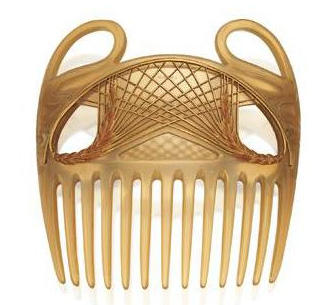I cannot believe there is a Lalique comb that hasn’t been featured on this blog. ;-P This one is “Drone with Umbels,” c. 1901-2. It is made from carved horn, gold, and enamel. An umbel is a flower consisting of a series of short stalks with small blooms, such as Queen Anne’s Lace.
Category Archives: Lalique
Lalique Icy Leaves
c.1904 – 1905. The comb is horn, the brim is gold, the leaves are tortoiseshell, and the diamonds make them look like ice.

There was an excellent doctoral thesis done on Lalique by Fallon Lee Miller of Eastern Michigan University in 2003. Beautifully referenced for scholarly research. I recommend taking the time to read it.
Blessed be the Genius…
Lalique’s cattleya orchid is made of ivory, gold, enamel, horn, and diamonds, c. 1903-1904, and resides in the Cleveland Museum of Art. However, the view we usually see of it does not reveal its secret: what René was really thinking when he made it. Last night, I found the truth. Blessed be the genius who loves a woman’s body with his flowers.
The Peacock
First, Rene made a simple horn comb. Then he attached a gold medallion with inlaid mother-of-pearl clovers. He elongated the horn on the top-right to frame a real peacock feather. To hold the feather in place, he carved and attached a magnificent gold bird, with its royal plumage of peacock feathers carved in gold flowing over the tines. What a beautiful idea of both art and engineering. c. 1902-1903.
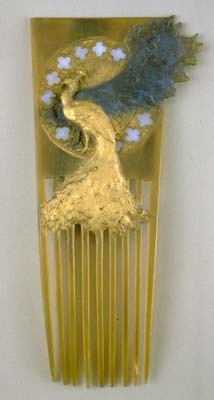
Another peacock dream Rene had was this pectoral. Usually associated with ancient Egypt as a medallion attached to a necklace, or a brooch, I think this piece could easily function as a barrette. Using the Symbolist philosophy of Art Nouveau, the peacock and its feathers are done in blue and green enamel accompanied by randomly set cabachon opals. Diamonds bookmark the piece. c. 1902-1903.
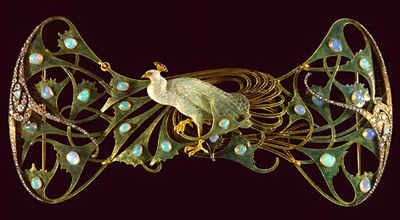
Bats and Sapphires
Rene Lalique made a comb he called, “Bats.” I did a collection of combs with rats and bats on them, I guess this was his entry into rodent life. :-) They are made of blue enamel on a horn comb.

This next one could not be more of a contrast. It’s a tiara of gold, enamel, and sapphires hinged to a horn comb, which a lady would wear to the opera to highlight a sumptuous blue gown. c.1902 – 1903. The comb resides at the Museum of Fine Arts in Boston.
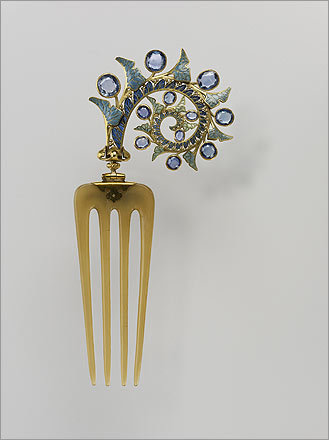
Lalique Tiara Comb
This tiara comb was made with Rene Lalique’s own hands, in Paris, c. 1903-4. The horn arches, which support the cast glass flowers, frame fire opals. The design rests on a band of enameled gold hinged to a horn comb.The comb resides in the Victoria and Albert Museum.
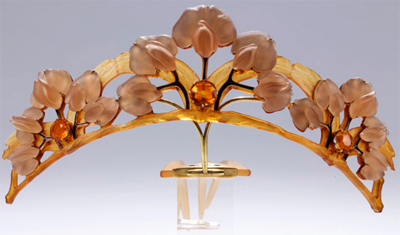

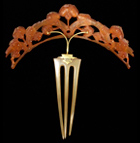
There’s A Story In This Sale
In April, 2008, Christies sold this Lalique horn comb with a blue and green enameled Japanese landscape and a sunset in yellowish orange enamel for $273,500. The comb was made c. 1900 and is one of Japonisme’s greatest expressions from the French side.
On 9/21/09, the SAME COMB was put on sale again with a price estimate of $15,000 to $20,000, and sold for $92,500. I don’t understand this at all. The only thing I can think of is that something happened to the finances of the previous buyer, and they were in trouble. I agree with the first price, just like I agree with the Galliard comb selling for $218,500. Who knows. Someone got a bargain. I hope they realize what they won.
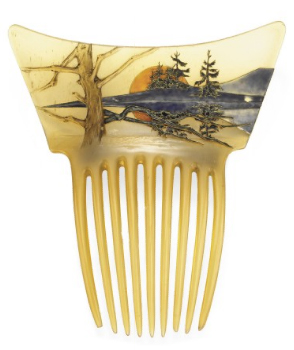
Japonisme: Lalique and Meiji Birds
After the opening up of trade routes to Japan, Edo and Meiji combs were introduced at the Paris exhibition of 1867. They took the European art world by storm and began a craze in France called Japonisme . It is interesting to compare Lalique’s masterpiece Two Swallows with a Stalk of Oats c. 1906-1908, carved horn gold and diamonds, with a Meiji kanzashi of plover birds.
In Swallows, Lalique incorporates the art nouveau philosophy of Symbolism: one thing transforms into another. He elongates the swallows’ wings to engineer the tines of the comb. It’s a double entendre.
The Meiji ornament, which went on a kanzashi stick, shows the relationship of a mated couple of plover birds in a tree. The shell used had different colors, which adds shadow, but the perspective and theme are realistic, emotional, and stunningly carved. The French skewed nature to match the intellectual ideas all art forms were using in that time. 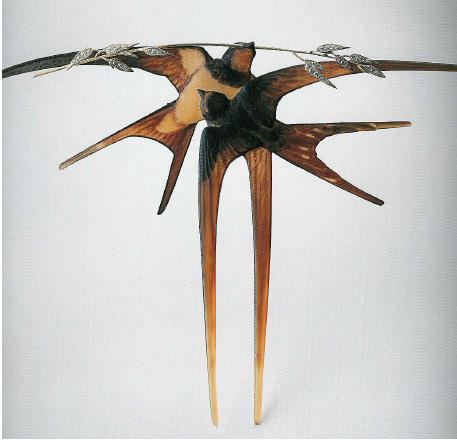
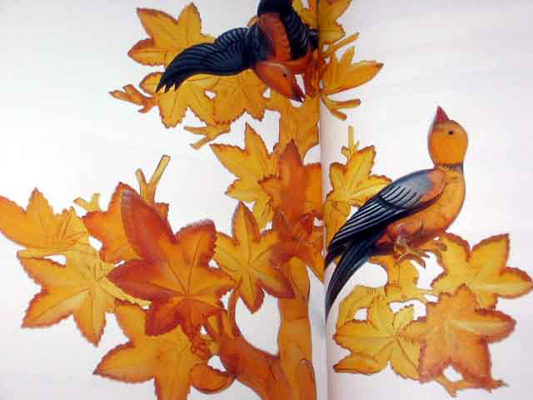
Lalique, the Master
He changed the imagination of the world for all time. Here are an orchid, and something I’ve never seen before: hair sticks with a bouquet of coral flowers on top, very geisha, very Japonisme. The cattleya orchid is made of ivory, gold, enamel, horn, and diamonds and resides in the Cleveland Museum of Art, c.1903-1904. The coral flowers grace the MuseeD’Orsay in Paris, c. 1902.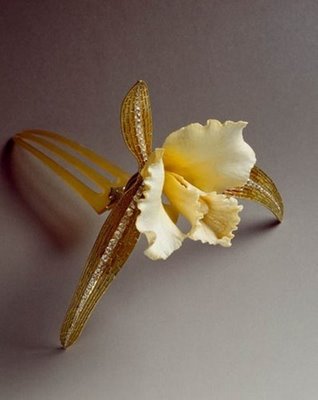
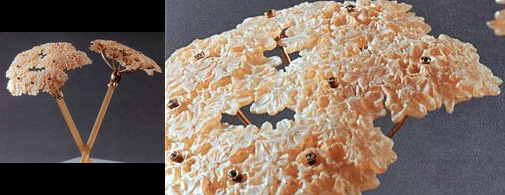
Lalique Horn Comb
Whiplash scrolls bookend this comb, bordered in gold plaque. Rene’s theme was wheat stalks with webbed terminals, which he realistically decorated in yellow and orange translucent enamel. He signed this one. c. 1900. This comb and the original drawing sold at Sotheby’s for $25,200.